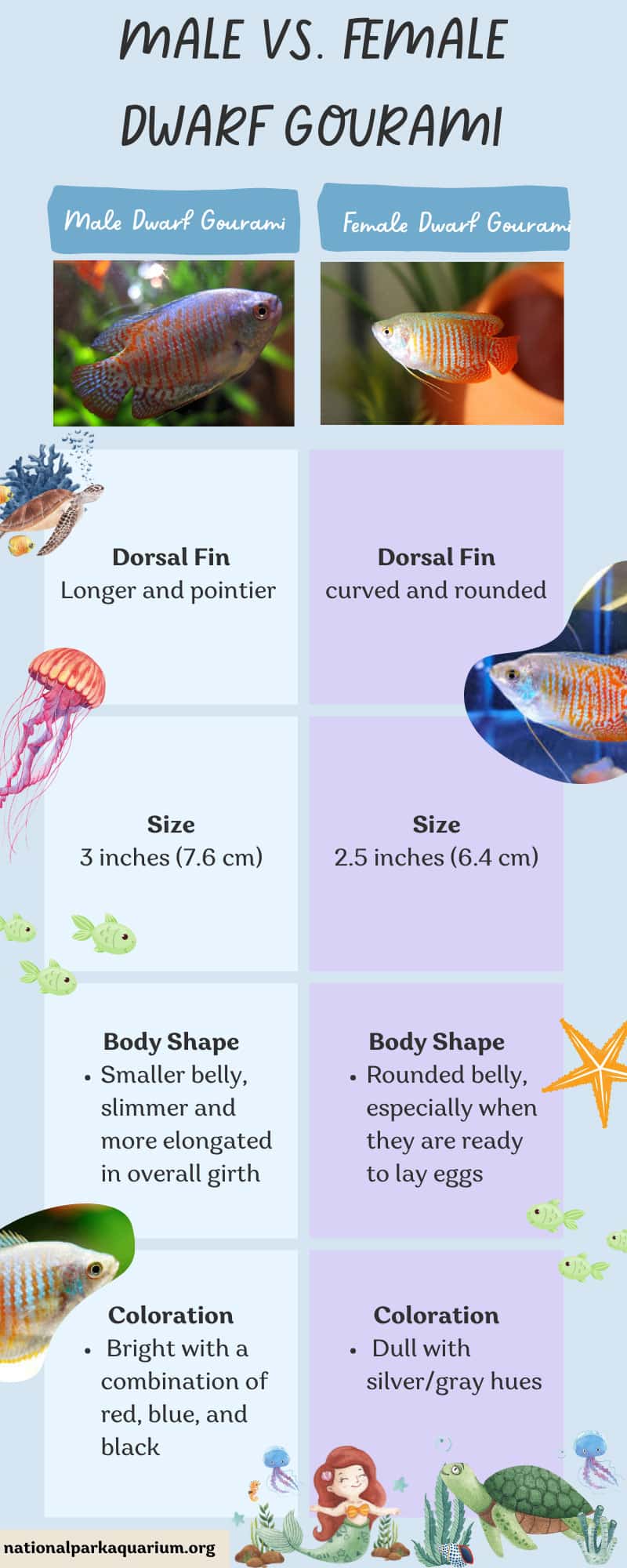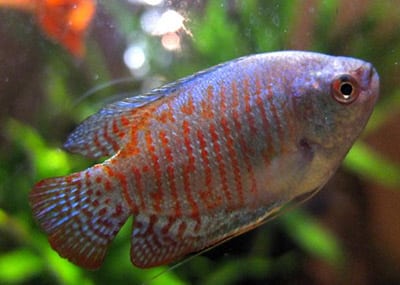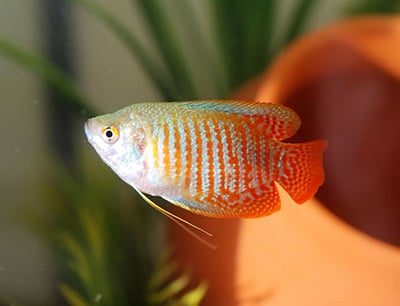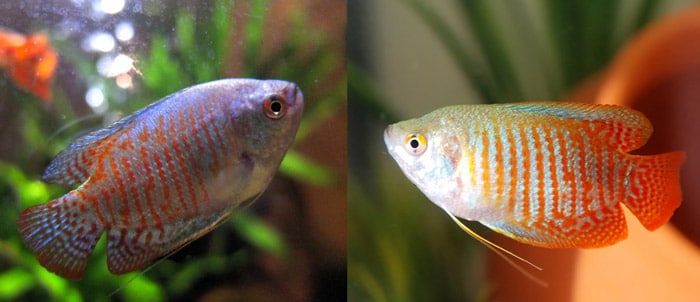You’ve been thinking about breeding dwarf gourami for some time now. Aside from its rainbow-like colors, you like that it is friendly, small, and can live with most fishes in your tank. And you also love that it is a low-maintenance fish.
But before you even think of breeding this fish, you must first know the difference between male and female gourami.
Like most fish species, there’s very little difference in the looks of male and female dwarf gourami. This makes it quite tricky for first-time aquarists to distinguish the sexes of the said fish.
Don’t worry as this article, National Park Aquarium will have you covered on comparing male vs. female dwarf gourami.
Differences Between Male and Female Dwarf Gourami
- Size: Around 2.5 inches
- Color: Dull with silver/gray hues.
- Dorsal Fin: Rounded.
- Belly: Small
- Fins and tail: Short
- Temperament: Aggressive when with other males
- Breeding behavior: Builds breeding nest
- Size: About 3 inches
- Color: Bright with combination of red, blue, and black.
- Dorsal Fin: Pointed
- Belly: Big.
- Fins and tail: Long
- Temperament: Aggressive when with other males
- Breeding behavior: Builds breeding nest

1. Size
In general, dwarf gouramis are tiny fishes. An adult can grow up to 3.5 inches.
Male dwarf gouramis are slightly larger compared to their female counterparts. Their average size is about 3 inches. On the other hand, female dwarf gouramis can grow up to 2.5 inches.
2. Color
Aside from being slightly larger, male dwarf gouramis tend to have more colorful bodies than female dwarf gouramis.
If you see a dwarf gourami with a red, black or blue color on its abdomen, face, and throat, then it is likely to be male. The colors are also more vivid, particularly during the spawning period.
Meanwhile, female dwarf gourami has duller colors. It generally has a silver-grayish body. Suffice it to say, its colors are much more subdued compared to those of male dwarf gourami.

3. Body Shape
Another distinction is the shape of the dwarf gourami’s body. For instance, the belly of the male dwarf gourami is smaller than that of its female counterpart. It, thus, makes the male dwarf gourami look slimmer than the female dwarf gourami.
Of course, the belly of a female dwarf gourami would even be bigger when it is breeding. The eggs make their belly more prominent.
Moreover, the male dwarf gourami has a pointed dorsal fin, which is located on top of its body. This is in contrast with the rounded dorsal fin of female dwarf gourami.
Female dwarf gouramis have shorter fins and tails compared to those of males. Their fins are also circular in shape, compared to the elongated fins of male dwarf gouramis.
It should be noted that the physical characteristics of both male and female dwarf gourami aren’t noticeable when the fish is a juvenile. These physical attributes are only prominent when the dwarf gourami reaches adulthood.
4. Temperament

If you’re still unable to determine the gender of a dwarf gourami based on its physical attributes, then you may want to observe its behavior while in the water.
While the male dwarf gourami is docile and friendly when with other fishes, it tends to become aggressive when with another male dwarf gourami.
The male dwarf gourami can also show aggression when the female dwarf gourami is introduced into the tank. It suddenly becomes territorial as it tries to impress the female fish while trying to scare off the other male dwarf gourami in the tank.
On the other hand, the female dwarf gourami is very timid. It will rarely show aggression with other fish. It prefers to swim along with male dwarf gourami when inside the tank.
The breeding behavior of male and female dwarf gourami is another difference between them. However, this would obviously become apparent to you once you’ve successfully paired a male dwarf gourami with a female one.
Male dwarf gourami would build a breeding nest, something that females don’t. You might spot the male dwarf gourami taking sand from the bottom of the tank, and swimming to the surface of a floating plant.
This is a common activity of male dwarf gourami when their partners are breeding. Lastly, it is the male dwarf gourami that takes care of their young.
For easy reference, here’s a table comparing the major differences between a male and female dwarf gourami:
Conclusion
To sum it up, a male dwarf gourami is usually longer than a female dwarf gourami. It is also more colorful, typically with black and blue hues on its body. In comparison, the female dwarf gourami has a dull appearance, usually colored gray or silver.
The male dwarf gourami has a pointed dorsal fin while the female one has a rounded dorsal fin. Females also have shorter fins and tails.
In terms of temperament, the male dwarf gourami is more aggressive especially when it lives with another male of its kind. Female dwarf gourami, on the other hand, is very docile.
And lastly, the male dwarf gourami takes care of its family such as its partner and its juveniles when breeding. These are the main differences between male vs. female dwarf gourami.




